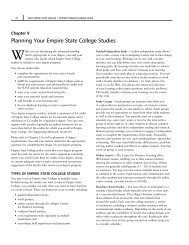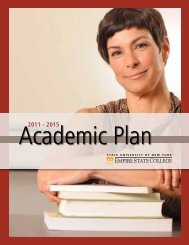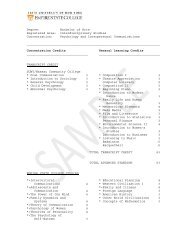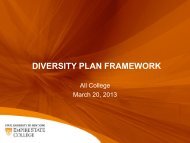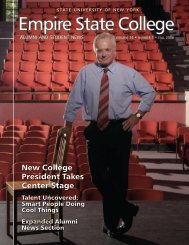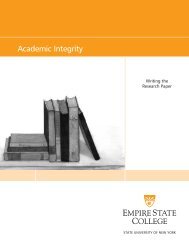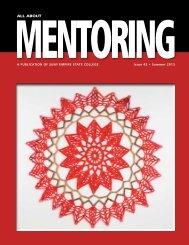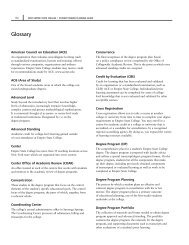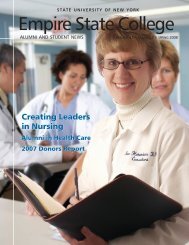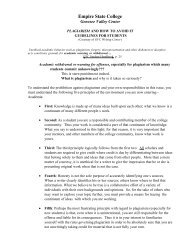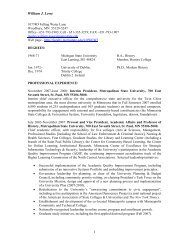All About Mentoring Spring 2011 - SUNY Empire State College
All About Mentoring Spring 2011 - SUNY Empire State College
All About Mentoring Spring 2011 - SUNY Empire State College
Create successful ePaper yourself
Turn your PDF publications into a flip-book with our unique Google optimized e-Paper software.
81<br />
Here are a few preliminary thoughts that are<br />
certainly open to debate.<br />
<strong>Empire</strong> <strong>State</strong> <strong>College</strong> and many of its<br />
competitor institutions were established<br />
as “student-centered” places. If college<br />
students, like high school students, are<br />
“hiring education” to be successful and to<br />
have fun, then how well do we meet those<br />
goals If retention data is even a slight<br />
indication, the answer is terribly. That is not<br />
a reflection on the quality or dedication of<br />
the leadership, mentors, teachers or staff –<br />
it is a simple empirical reality. There are<br />
several ways to address these issues.<br />
As a strategic matter, the college’s upper<br />
administration would need to determine<br />
whether or not it wants to pursue disruptive<br />
technologies at all. If so, then the next<br />
decision is what should those disruptions<br />
be and where should they be housed. For<br />
example, the college’s decision-makers might<br />
determine that, rather than using course<br />
management systems, they want to invest<br />
in smart phone delivery of education. They<br />
might want to serve nonnative speakers<br />
of English, either using English language<br />
literacy enhancement or teaching courses<br />
exclusively in Spanish. They might want to<br />
teach courses through Twitter and Facebook<br />
or the next new social media platform. In<br />
principle, there are many possibilities one<br />
might explore; these are only illustrative.<br />
Whether the answer is “yes” or “no,” the<br />
college could still do much to enhance its<br />
strategic position. Organizational changes,<br />
reducing the complexity of existing<br />
processes, and reducing costs in a way that<br />
the organization could do more with its<br />
limited resources, could all be beneficial in<br />
a sustaining sort of way – doing the things<br />
we do now but more efficiently. There<br />
would no doubt be pushback from people<br />
imbued with an organizational culture<br />
committed to existing ways of performing<br />
their jobs. Some measure of increasing<br />
organizational efficiencies of the sort I just<br />
described has a value in itself, but it is not<br />
really disruptive. Creating a whole new<br />
platform (like a smart phone) on which to<br />
teach and mentor students or to measure<br />
student success at accomplishing their<br />
goals, or serving students who now rarely<br />
go to college if at all (like monolingual or<br />
weakly bilingual Spanish speakers) would<br />
be disruptive. These approaches would<br />
be effective ways to compete in a market<br />
against other schools that have similar kinds<br />
of student populations or philosophical<br />
goals. It would throw light on some of the<br />
basic assumptions – about technologies,<br />
processes and student populations – that we<br />
rarely question.<br />
Interestingly, the Innosight report,<br />
Disrupting <strong>College</strong>, is less helpful to those<br />
of us in adult and nontraditional education<br />
than is Christensen’s earlier work. His<br />
observations about “measuring” success<br />
after graduation (for example, using<br />
placement rates, salary improvements,<br />
retrospective satisfaction ratings, and cohort<br />
default rates on loans) are all interesting and<br />
useful and perhaps more valuable measures<br />
than some of the tools we are using now. In<br />
this context, Christensen and his co-authors<br />
would define “success” based on students<br />
determining when they have accomplished<br />
their goals, no matter how instrumental they<br />
may seem. At an institution where student<br />
goals and wants are so central to defining<br />
the terms of an education, what would<br />
student and employer input in measuring the<br />
“value” of an education be<br />
While Christensen’s team’s analysis in<br />
the Innosight report is quite good, it is<br />
reminiscent of points made in the earlier<br />
work. The team’s examples of disruption<br />
and disruptive technologies for learning<br />
apply well to traditional institutions, but<br />
less so to nontraditional schools. Online<br />
learning is his primary example of a<br />
disruptive technology; yet, <strong>Empire</strong> <strong>State</strong><br />
<strong>College</strong> has been delivering learning online<br />
for at least 15 years. The issue at <strong>Empire</strong><br />
<strong>State</strong> <strong>College</strong> is less about adopting online<br />
learning, and more about how to compete<br />
against other low-cost colleges who do it<br />
too (especially if we believe that growth in<br />
numbers is to our overall long-term strategic<br />
advantage). The pressure here, I think, is to<br />
move “upmarket” and offer “better” online<br />
learning than the low-cost and often forprofit<br />
competition.<br />
For example, Christensen describes Western<br />
Governors University and its new location<br />
in Indiana (Christensen, Horn, Caldera,<br />
& Soares, <strong>2011</strong>, p. 50). WGU-Indiana is<br />
“competency based” rather than “credit<br />
based.” That is a decades-old idea, but<br />
state departments of education and other<br />
regulatory bodies pushed colleges to move<br />
toward systems that could easily measure<br />
Carnegie units (so-called seat time as<br />
the requirement for learning). Although<br />
competency-based models have fallen<br />
out of favor because of pressures to meet<br />
Carnegie unit expectations, they could make<br />
a comeback in the new circumstance that<br />
Christensen describes.<br />
Adult students are no<br />
longer an attractive<br />
market niche in this sense<br />
because many schools are<br />
now catering to them<br />
… online learning itself<br />
is no longer an attractive<br />
niche either.<br />
New Marketing Niches<br />
Christensen and his co-authors would<br />
propose focusing on nonconsumers of<br />
education and concentrating on areas that<br />
are not really attractive to the college’s<br />
competitors. Christensen proposes that<br />
schools target student populations that they<br />
can serve uniquely. <strong>Empire</strong> <strong>State</strong> <strong>College</strong><br />
has done that for years. Rather than move<br />
upmarket and serve those same students<br />
“better,” it might be more valuable to look<br />
for different markets of nonconsumers.<br />
Thus, at the beginning of a disruptive cycle,<br />
the quality of education may not be as<br />
good as other education the college already<br />
provides. It may take a while to reach that<br />
level. But if it meets the goals of the new<br />
students, who were previously not going to<br />
college or were having miserable experiences<br />
during the limited time in college at <strong>Empire</strong><br />
<strong>State</strong> <strong>College</strong> or elsewhere, then students<br />
will be happier and feel their needs are being<br />
met. These students will not exactly be like<br />
<strong>Empire</strong> <strong>State</strong> <strong>College</strong>’s existing students or<br />
they may not need exactly what <strong>Empire</strong><br />
<strong>State</strong> <strong>College</strong> is now delivering, but the new<br />
consumers might be satisfied anyway.<br />
Adult students are no longer an attractive<br />
market niche in this sense because many<br />
schools are now catering to them. In this<br />
suny empire state college • all about mentoring • issue 39 • spring <strong>2011</strong>




